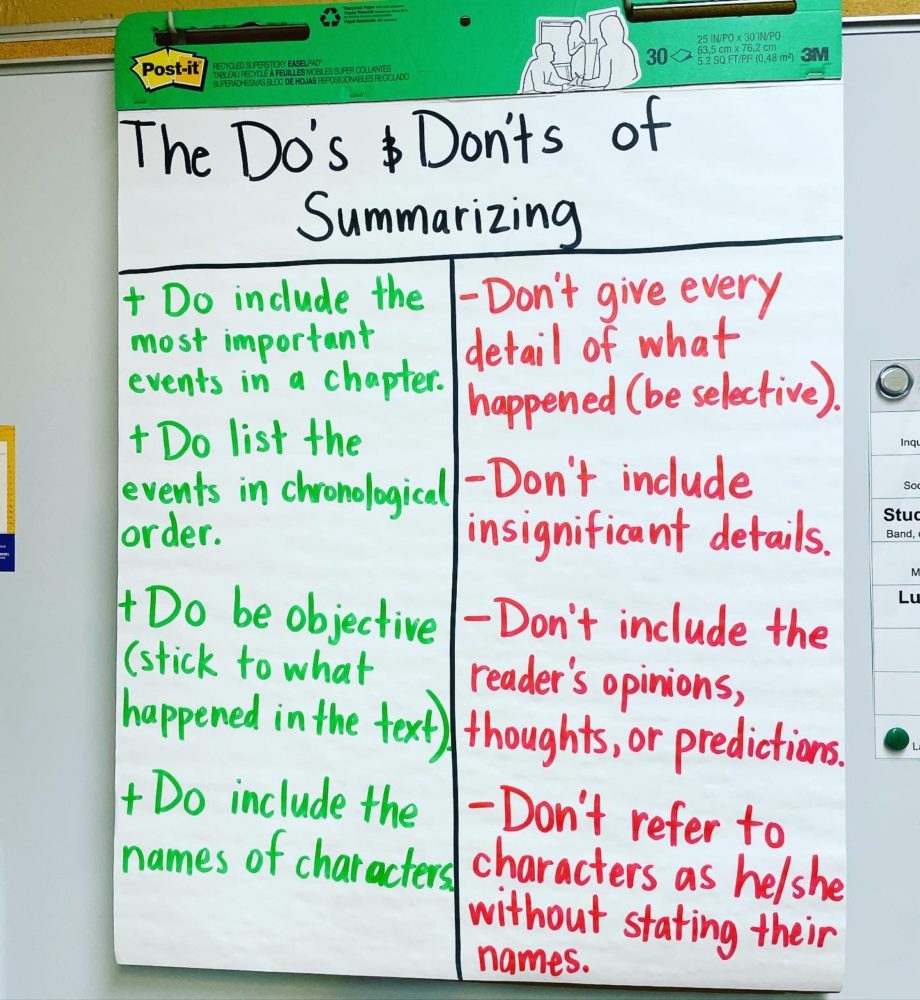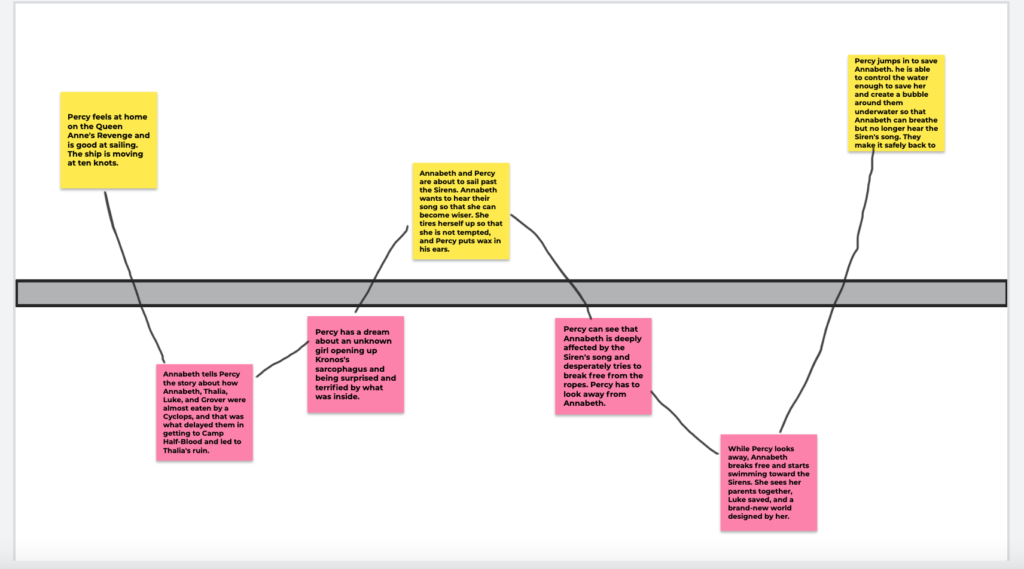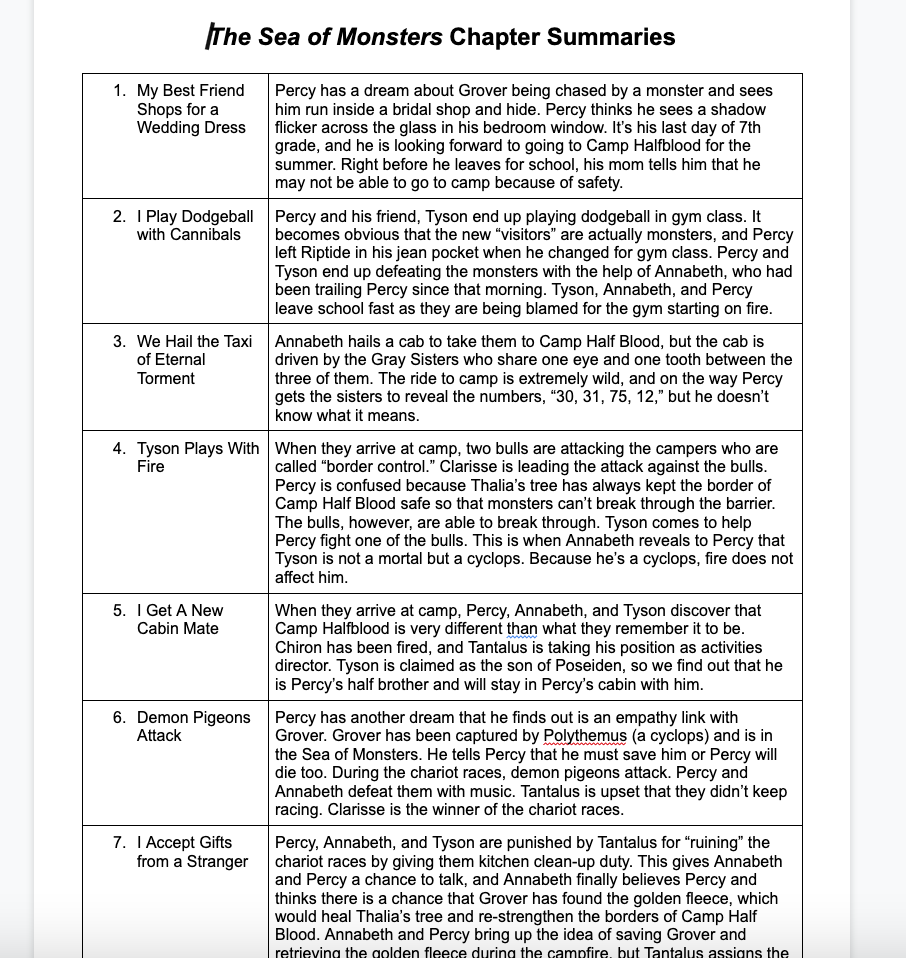The reading skill of being able to summarize a chapter of text is often overlooked. I recently asked a student to tell me what happened in the chapter she had just read. Her response was, “I don’t know. I’m reading the words, but I’m not thinking about what is actually happening.” I’ve also asked students why they can recite word-for-word what’s going on in the plot of our read aloud book but can’t explain the plot of an independent reading book. Their response: “When you read it aloud, I get it, but when I read it to myself, I lose track of what’s going on.”
I am 100% guilty of making the assumption that middle school students know how to summarize a text and are proficient at doing so. As I teach 6th grade Language Arts this year, I am learning that my assumption is quite wrong. I’ve also noticed that students’ inability to summarize their reading is making other ways of thinking about reading hard as well. It’s hard to make connections, infer, predict, analyze, or critique a text when you don’t know what’s going on in the plot.
This is why summarizing is a reading skill that we need to be intentional about as we’re planning our curriculum and daily instructional practices. In this blog post, I’m going to outline five ways to incorporate instruction around summarizing into your curriculum and/or instructional practices.
Before starting any of these ideas though, make sure your students know what summarizing actually is (and what it is not). Here is an anchor chart I used this year to give students a common understanding of what summarizing is. I refer to it often.

Idea One: Change Your Prompting
We often use the prompt, “Summarize what you’ve read” when asking students to summarize. If your students aren’t responding well to this prompt, mix it up a bit with how you ask the question. Sometimes the slightest change in how you question a student can make a big difference in their response. Here are a few ideas for what to say instead:
- What do you think the author wants the reader to remember about this chapter?
- How did the main conflict build or work toward a resolution in this chapter?
- What happened to the main character in this chapter of the book?
I also want to note that in the prompts above, I focused my wording on asking students to summarize a chapter. It is an overwhelming task to ask students to summarize what has happened in an entire book up to that point, so I recommend focusing the initial prompt you ask around a specific part of the book. However, the above prompts can lead to a follow-up question about what happened previously. Here are some follow-up prompts:
- How did the conflict build up to this point?
- What are the most important things that happened to the main character leading up to this chapter?
Idea Two: Summarizing Roller Coaster
Make summarizing visual with this fun graphic organizer. It’s simply a Google Jamboard with a line in the middle that students add sticky notes to. Here’s how it works:
- I tell students that the line represents neutral. Any plot event placed above the line is something that was positive for the main character. Any plot event placed below the line is something that was negative for the main character.
- The plot events are added in chronological order as you travel horizontally across the line.
- Students can decide how far above or how far below the line the plot event from that chapter should be placed. This will vary for each event.
- Students should describe each plot event in detail.
- After all the events from the chapter are plotted, draw a line from one event to the other to show the “roller coaster” effect.
Since it’s a Google Jamboard, you could decide if you want students to do this individually or possibly with a partner or small group collaboratively if students are reading the same book for small group reading instruction.

Idea Three: Partner Reading Routine
If your students could use fluency and summarizing practice, this is a great 3-5 minute routine to add into the beginning of class several days per week. Here is the format I follow.
- Have students turn to the page they are on in their independent reading book and select one full page of text from the previous five pages.
- Students partner up and take turns reading their selected page to one another.
- Once each student reads their page aloud, they respond to the prompt, “What plot events led up to what was happening on this page?”
I enjoy this addition to a middle school literacy framework in regards to summarizing because it brings students directly into their independent reading book and keeps them thinking about how the plot of the book is connecting together.
Idea Four: Model Summarizing in Interactive Read Aloud
If you have the opportunity to do whole class read alouds with novels, there is no better way to help students strengthen their summarizing skills than to model it and have students co-construct chapter summaries with you. Our last interactive read aloud was The Sea of Monsters by Rick Riordan, and we kept a simple Google Doc of chapter summaries throughout our reading that I’ll link here. I would recommend mixing up how the summaries are created daily. Here are a few ideas:
- Model to students what you thought the main events of the chapter were and type the chapter summary in real time in front of them.
- Ask students to talk with a partner about how they would summarize the main events the chapter that day, and then co-construct the chapter summary as a whole class.
- Give all students access to the Google Doc and assign one student or a several students to type the chapter summary in real time as you’re reading the chapter that day.
This is also super nice for when students are absent and to show students how different pieces of the book connect together.

Idea Five: Spiral Your Curriculum
If you teach 5-7 reading units across the school year or do Reading Workshop across the entire school year, teaching reading minilessons that focus on summarizing shouldn’t be a one-time event. I aim to teach reading minilessons focused on an aspect of summarizing in every single reading unit that I teach. Students need the opportunity to practice summarizing in different genres and through different lenses.
Unfortunately, reading behaviors are sometimes taught as a week-long unit and checked off the list instead incorporated strategically across the school year. Practicing summarizing for a week straight and then never coming back to it isn’t enough.
If you’re searching for a middle school reading curriculum that spirals without being repetitive, check out my middle school reading units. There are 7 reading units in total based on 7 different genres of reading. Each unit contains 20 unique reading minilessons, so the year-long reading curriculum contains 140 different reading minilessons in total. You can check out the year-long curriculum here and the individual units below.
Realistic Fiction Reading Unit
Historical Fiction Reading Unit
Science Fiction/Fantasy Reading Unit
Expository Nonfiction Reading Unit
Memoir Reading Unit
Reading Unit Growing Bundle
Here’s to strengthening middle school students’ reading skills and strategies!
Kasey





